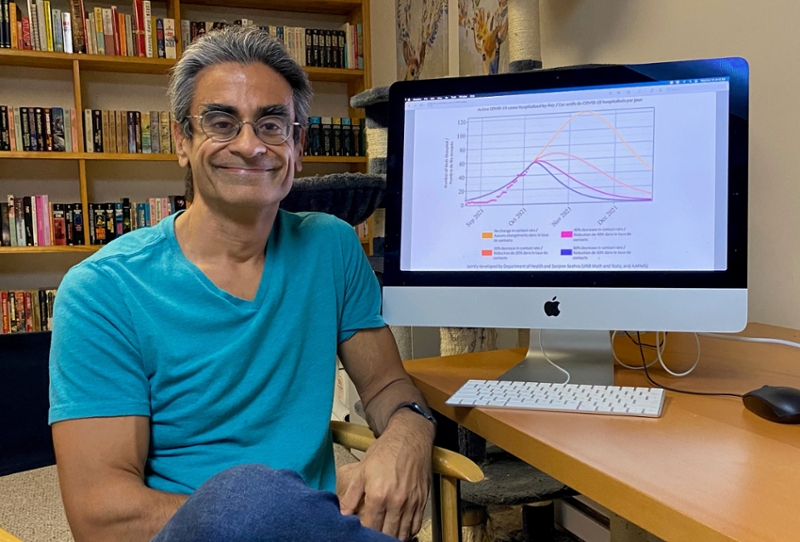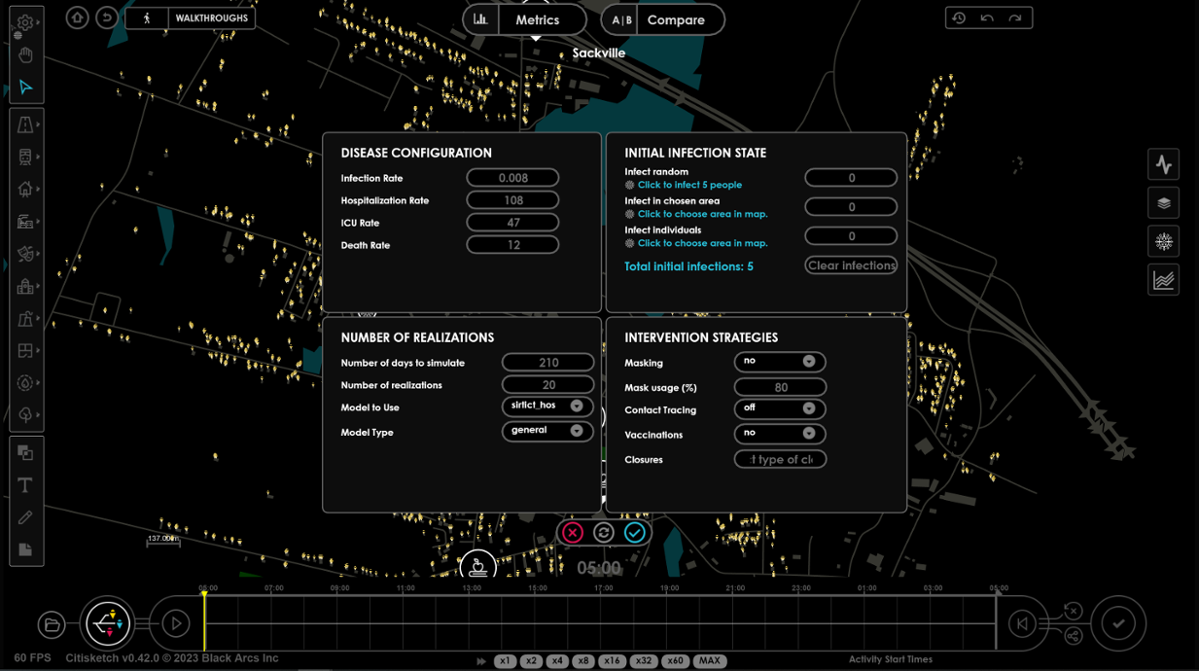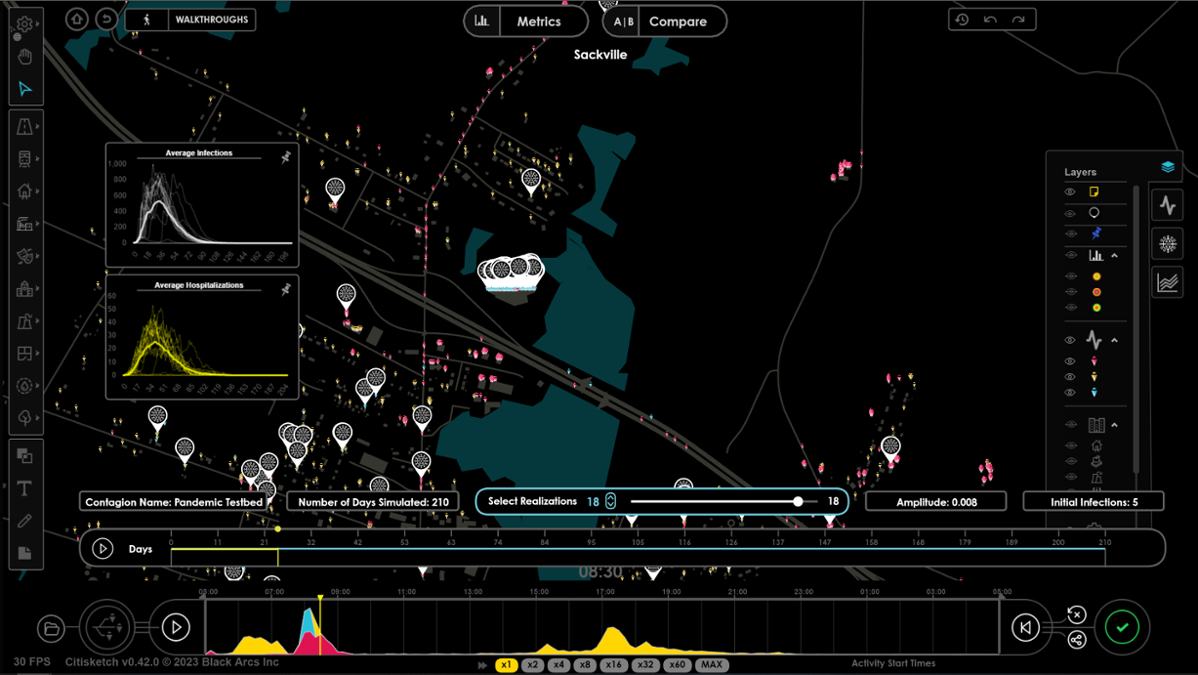UNB experts join Black Arcs to create novel disease modelling system
Author: UNB Research
Posted on Jun 20, 2023
Category: Faculty of Science , COVID-19 , Partnerships , Research , Innovation & Commercialization

At the height of COVID-19, Fredericton company Black Arcs knew they could help governments and experts with better pandemic response planning.
They already had Citisketch, a product that simulates the daily life of communities; how people move around and behave throughout their day. They’d built it with trusted, anonymized statistical data and knew it provided reliable insights about community-level contact. It could iterate through new scenarios quickly and provide a visual, more intuitive presentation of data.
They just needed one thing: The virus.
Or, rather, a virtual version of it.
“Citisketch was designed to simulate movement in communities for many different planning and analysis purposes,” said Dr. Jake Arsenault, CEO of Black Arcs. “Since it shows how individuals and families move around and congregate within cities, we saw the potential to help people understand how to fight communicable diseases in new ways, if we could create a way to simulate the disease within Citisketch.”
They would find that virtual virus in the minds of researchers at the University of New Brunswick (UNB).
Black Arcs initially brought the question to an Industrial Problem-Solving Workshop organized by the Atlantic Association for Research in the Mathematical Sciences (AARMS). There, they would collaborate with Dr. Sanjeev Seahra, a professor of mathematics and statistics at UNB and the director of AARMS, as well as Dr. Suprio Ray, a professor of computer science.
Seahra was already working with public health officials to provide mathematical modelling for the pandemic. These models – complex calculations that consider a variety of factors based on existing data and reasonable estimates – worked well for that purpose. But, according to Seahra, there was room for improvement.
"The simplest disease models are good at efficiently predicting broad trends in an epidemic’s trajectory but cannot capture the fine details of things like testing and contact tracing,” he said. “On the other hand, the existing, more complicated models we had access to were too unwieldy and slow to analyze multiple possible scenarios.”
Seeing initial success during the workshop, Black Arcs and Seahra continued to collaborate on creating this new model to simulate COVID-19’s behaviour, building and refining a model that can both incorporate several real-world details and iterate through multiple scenarios quickly.
“The modelling framework for this project was something novel and we essentially developed it from scratch in collaboration with Black Arcs,” said Seahra. “The respiratory infectious disease model itself was modified from some of my older work.”
Over the past two years, Seahra, Ray and a team of UNB researchers - two undergraduate students, one master’s student, two PhD students and one postdoctoral fellow - have contributed their expertise to this project.
 The result is a system where you can adjust one or more parameters – for example, masking, isolation mandates, vaccination rates and efficacy or disease parameters such as the infection rate and hospitalization rate – and, in seconds, see how it plays out in this synthetic, digital twin of a community.
The result is a system where you can adjust one or more parameters – for example, masking, isolation mandates, vaccination rates and efficacy or disease parameters such as the infection rate and hospitalization rate – and, in seconds, see how it plays out in this synthetic, digital twin of a community.
“Our tools allow outbreaks to be started at specific buildings, within a specific geographical area, or even in specific synthetic people,” said Dane Sheppard, Black Arcs director of technology. “Altogether, our system allows you to identify high-risk outbreak scenarios and iterate on effective intervention strategies at a very granular level.”
In addition to developing the disease model Black Arcs needed, the project also provided researchers with a unique opportunity.
“I think this has been an excellent experience for these students, allowing them to combine fairly sophisticated mathematical modelling with commercial-grade software development,” said Seahra.
“From my own perspective, it has also been quite rewarding. Building something like the Black Arcs community simulation software is well outside my expertise, so having access to the platform and its development team has opened up some exciting and unexpected modelling possibilities.”
The project team members weren’t the only ones to see this new modelling system’s potential value and impact. With a letter of support from the Public Health Agency of Canada in hand, Black Arcs received a $1-million grant through the Department of National Defence (DND). DND’s Innovation for Defence Excellence and Security (IDEaS) program provides funding to assist Canadian innovators in solving defence and security challenges.
DND’s mandate is to support civilian authorities during a broad range of crisis events, including public health emergencies. During the COVID-19 pandemic, this resulted in mobilizing significant assets, including orienting funding programs to rapidly advance innovation.
The Black Arcs project was among 21 projects funded under the “Rapid response: Real-time insights for pandemic decision-making challenge” and one of only three granted more than $900,000.
"The Department of National Defence has been a great partner on this project,” said Arsenault. “They are looking for new digital tools that enable their analysts to do more with the immense amount of data they have access to but need tools that fit into their processes. Working with them has helped us develop a flexible, open system that will help manage future disease outbreaks and other crises.”
Though the initial COVID-19 crisis has ebbed, with the World Health Organization no longer classifying it as a global health emergency, COVID-19 and other communicable diseases and new viruses will remain part of our lives. By leveraging two innovations together – a community, digital-twin platform focused on daily life and a streamlined mathematical disease model – this university-industry collaboration will enable new insights and efficiencies in how we respond to them.
